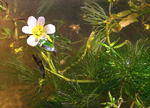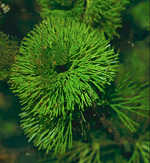 |
This is a small family from the tropics and warm-temperate regions of all continents. Brasenia is widespread in mainland eastern Australia, but is not common. Cabomba is an aquarium plant that has become a serious weed in many parts of the world; it has been collected from coastal NSW.
Characteristic features of the family Cabombaceae in Australia include: - waterplants with peltate, floating leaves or much-divided submerged ones
- flowers white, yellow, pink, dark red or purple, floating or emergent, with 6-8 perianth parts
- ovary superior with free carpels
Description
Perennial aquatic herbs, free-floating or rooted in the substrate, with their leaves mostly all submerged or floating, perennating by rhizomes. Vegetative reproduction by stolons or stem fragments. Stem internodes spongy or pithy. Internal secretions not obvious. Plants glabrous. Leaves alternate and spiral, opposite or in whorls of 3, cauline, petiolate, or peltate. Stipules and stipellae absent. Lamina simple or tricompound, palmate, symmetric, palmatifid or palmatisect; lanceolate, ovate, elliptic or orbicular; base rounded or hastate or sagittate; margins entire, ±flat; one-veined, or the venation pinnate, or palmate, with the midrib inconspicuous, and the tertiary venation not reticulate; surfaces not punctate; herbaceous or leathery. Plants with all the flowers bisexual. Inflorescences axillary, consisting of solitary flowers. Bracts and bracteoles absent. Pollination by insects. Flowers odourless; stalked. Floral disc absent; nectaries absent or present on the perianth. Perianth of 2 dissimilar whorls, or of 1 whorl only, or all whorls ±similar, with 2–8 segments. Calyx regular; segments free, with 3 sepals, ?valvate or ?open in bud. Corolla regular, with 2–8 free petals, alternating with the sepals, imbricate in bud, white, yellow, red, pink, magenta or purple, without contrasting markings, membranous; claws present or absent; lobes ±entire. Fertile stamens 3–6 or 12–18, both alternating with and opposite to, or not clearly correlated with, the sepals, free of the corolla, free of the ovary and style, distinct from each other, all ±equal. Anthers basifixed, not versatile, opening outwards by longitudinal slits; 2-celled. Ovary superior and sessile. Carpels (1–) 2–18, free. Style terminal, single and unbranched. Ovules (1–) 2 or 3 per locule, stalked; placentation laminate. Fruit dry, indehiscent, achene-like (achenetum) or follicle-like (diclesetum); the perianth on the maturing fruit deciduous. Disseminule micro-surface ±smooth or with a single tubercle, dull. Seeds 1–2 per fruit. Aril absent. Cotyledons 2. Embryo ?round.
(Note: this description has been generated from the coded data compiled for the key. Any errors in the key data will be reflected in the descriptions.)
A treatment of the family Cabombaceae has not yet been published in the
Flora of Australia. It will appear in Volume 2.
Australian genera of Cabombaceae (as recognised for the Flora of Australia)
* = all species introduced
Brasenia
*Cabomba

|
  |

Cabomba caroliniana (flowering plant)
Photo: S.Jacobs © S.Jacobs

Cabomba caroliniana (habit)
Photo: S.Jacobs © S.Jacobs
|
 |
|